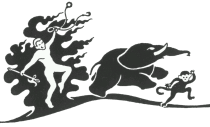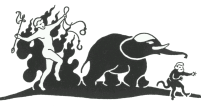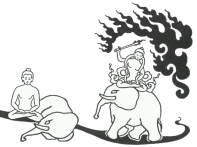 |
The
first panel depicts
several mental functions during the first phase of concentration practice,
when the meditator repeatedly attempts to focus attention one-pointedly on
a single object, either external or internal. The meditator starts out on
the path of well learned instructions equipped with shackles and goad
which represent short term memory and the monitoring function, to catch
and subdue the wild elephant of mind. The elephant's black color
represents undergrousal of mind, which hinders clear perception of the
object and eventually leads to drowsiness. The monkey represents
distraction, and its black color is caused by overarousal of mind. After
each failure to maintain one-pointed attention on the object the meditator
must determine wether it was due to over- or under- arousal and take
corrective measures for the next trial. The fire, decreasing in size from
the first to the seventh stages, and absent thereafter, indicates the
degree of effort required at each stage until concentration becomes
'spontaneous'. |
 |
The
second stage is
achieved mainly through development of short-term working memory and
involves lengthening the period of unbroken concentration.
From the second stage on, the
blackness of monkey and elephant begins to diminish, indicating the
decreasing tendency toward over- and under-arousal and resulting in less
distractibility and a clearer grasp of the object. |
 |
By
the third stage the
meditator has fastenend the shackle (short-term- memory) firmly to the
elephant of mind but is still pulled along behind. Lacking full control,
the meditator must continue to refocus attention after each lapse.
However, the period of unbroken concentration is longer and less effort is
expending. A hare appears for the first time, symbolizing a subtle aspect
of the hindrance of over-arousal due to the effort required to establish
concentration. |
 |
At the
fourth stage,
development of the monitoring function (a goad-a sence for the level of
activity of the nervous system) and the extension of the period of
short-term memory permit finer control during concentration. The factors
of over- and under-arousal are greatly reduced both during and in-between
the actual state of absorption, as is the effort required to establish the
absorption state. At this stage normally positive mental functions will
distract the mind from the object and must be suppressed during
concentration practice. It is no longer necessary to reset the mind again,
since the developed short-term memory and the monitoring function acting
together permit correction of over- and under-arousal before losing the
object. |
 |
By the
fifth stage the mind
tends to be drawn automatically toward the object, and thus the monitoring
function itself, which tends to increase arousal and lead to distraction,
must be released. The fire of effort is small and the hare is absent, the
mind is said to be pacified. |
 |
At the
sixth stage, the
monkey of distraction has faded out, and the blackness of mental
sluggishness has almost disappeared from the elephant of mind. Only the
slightest over- or under-arousal disturbs the absorption state and this is
easily corrected with slight effort before concentration
falls. |
 |
At the
seventh stage the
monkey is completly gone, the elephant is completely white and is
untouched by distraction or sluggishness. Gone also are shackle and goad,
because short-term memory and the monitoring function are needed only to
establish the actual absorption state, which is now 'effortless'. Finally
the meditator seated and at rest, has achieved perfect mental euqanimity.
This is attended by mental and physical ecstasy, the latter felt as a
pleasurable lightness symbolized by flying. The resulting perfect control
on mental functioning (riding on the elephant) serves as a basis for
advanced practices such as 'analytic Insight' (Vipassana). This again
requires effort (fire) and analytic thought (sword in the hand of
Manjushri, with whom you can identify now) firmly combined with perfect
concentration. Substantial development of concentration skill can be
achieved in as little as six months with proper condition, instructions
and guidance. However, developed concentration alone tends to degenerate
unless it is applied to advanced analytic techniques as mentioned
above. |


